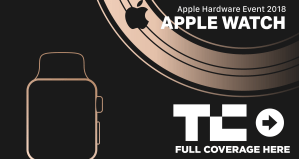I’m sure somewhere out there, there’s someone who wants nothing more in this world than a circular Apple Watch. That person, I’m sad to report, was once again disappointed with the outcome of yet another Apple event. Circle-sporting invites and office buildings aside, the squircle works well for Apple, so it’s sticking around for the time being.
In fact, that was a bit of a broader theme with today’s announcements — most of the updated Apple brand magic is happening under the hood here. That said, there is one key distinction from an aesthetic standpoint this time around: the logical extension of Apple’s ongoing war against bezels.
The display is 30 percent larger than the one on the Series 3, by Apple’s count. The new watch isn’t “edge to edge” as some early leaks put it, but the bezel size has shrunk considerably. Here’s a side by side image, courtesy of Apple:

The 44mm version’s display now measures 977 sq mm (versus the 3’s 740 sq mm), while the 40mm case is 759 sq mm (to the 3’s 563 sq mm) — so the smaller version of the 4 actually has a larger display than the larger 3. The reduction of the bezel was less of an aesthetic decision and more about cramming more information into the Watch’s relatively limited real estate.
When you’re dealing with something small enough to fit on your wrist, you take every spare millimeter you can get. Also notable is the fact that Apple’s slimmed things down here to 10.7mm from 11.4mm. Honestly, I’m surprised the company didn’t spend a little more time on that. Again, with wearables, a few millimeters go a long way.

The back of the device looks a bit different, as well. That comes courtesy of the electrocardiogram. That bit got what was easily the biggest applause line of the Watch announcement. People didn’t have to wait for Apple to break that one down. The new sensor makes it possible to detect heart rhythm, in addition to rate. That’s going to be a big thing for users with certain heart diseases.
It’s also the latest indication of Apple’s ongoing focus on health in addition to fitness. Ditto for improvements to the gyroscope and accelerometer, which make it possible for the watch to detect falls and send out an emergency alert accordingly.
Better battery life is always a biggie for wearables. That’s obviously one of those pieces we’re going to have to wait until we get our review unit in order to test. According to Apple, the number should be roughly the same as what you’ll find on the Series 3 — amounting to around 18 hours or “all day,” per the included press material.
There are other updates throughout, including a 2x faster chip (again, jury’s out until we can properly test) and a 50 percent louder speaker. Unlike the addition of LTE with last year’s model, the new features don’t jump out as earth-shaking updates over the previous model. Instead, the company’s just making the most well-rounded (so to speak) smartwatch that much better.
As ever, the Apple Watch is the one to beat.

